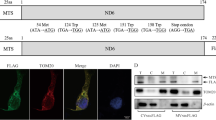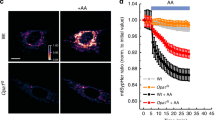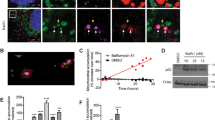Abstract
Leber’s hereditary optic neuropathy (LHON) is associated with mitochondrial DNA point mutations affecting different subunits of complex I. By replacing glucose with galactose in the medium, cybrids harboring each of the three LHON pathogenic mutations (11778/ND4, 3460/ND1, 14484/ND6) suffered a profound ATP depletion over a few hours and underwent apoptotic cell death, which was caspase-independent. Control cybrids were unaffected. In addition to cytochrome c, apoptosis inducing factor (AIF) and endonuclease G (EndoG) were also released from the mitochondria into the cytosol in LHON cybrids, but not in control cells. Exposure of isolated nuclei to cytosolic fractions from LHON cybrids maintained in galactose medium caused nuclear fragmentation, which was strongly reduced by immuno-depletion with anti-AIF and anti-EndoG antibodies. In conclusion, the caspase-independent death of LHON cybrids incubated in galactose medium is triggered by rapid ATP depletion and mediated by AIF and EndoG.
Similar content being viewed by others
References
Newman NJ. Leber’s optic neuropathy. In: Miller NR, Newman NJ, eds. Walsh and Hoyt’s Clinical Neuro-Ophthalmology. Baltimore: Williams & Wilkins 1998: 742–753.
Carelli V. Leber’s hereditary optic neuropathy. In: Schapira AHV and Di Mauro S eds, 2nd Mitochondrial Disorders in Neurology 2. Boston: Butterworth-Heinemann Blue Books of Practical Neurology 2002: 115–142.
Brown MD. The enigmatic relationship between mitochondrial dysfunction and Leber’s hereditary optic neuropathy. J Neurol Sci 1999; 165: 1–5.
Carelli V, Ross-Cisneros FN, Sadun AA. Mitochondrial dysfunction as a cause of optic neuropathies. Prog Retin Eye Res 2004; 23: 53–89.
King MP, Attardi G. Isolation of human cell lines lacking mitochondrial DNA. Methods Enzymol 1996; 264: 304–313.
Danielson SR, Wong A, Carelli V, Martinuzzi A, Schapira AHV, Cortopassi AG. Cells bearing mutations causing Leber’s hereditary optic neuropathy are sensitized to Fas-Induced apoptosis. J Biol Chem 2002; 277: 5810–5815.
Robinson BH, Petrova-Benedict R, Buncic JR, Wallace DC. Nonviability of cells with oxidative defects in galactose medium: A screening test for affected patient fibroblasts. Biochem Med Metab Biol 1992; 48: 122–126.
Ghelli A, Zanna C, Porcelli AM, et al.. Leber’s hereditary optic neuropathy (LHON) pathogenic mutations induce mitochondrial-dependent apoptotic death in transmitochondrial cells incubated with galactose medium. J Biol Chem 2003; 278: 4145–4150.
Zanna C, Ghelli A, Porcelli AM, Carelli V, Martinuzzi A, Rugolo M. Apoptotic cell death of cybrids bearing LHON mutations is caspase-independent. Ann NY Acad Sci 2003; 1010: 213–217.
Zou H, Henzel WJ, Liu X, Lutschg A, Wang XD. Apaf-1, a human protein homologous to C. elegans CED-4, participates in cytochrome c-dependent activation of caspase-3. Cell 1997; 90: 405–413.
Li P, Nijhawan D, Budihardjo I, et al.. Cytochrome c and dATP-dependent formation of Apaf-1/caspase-9 complex initiates an apoptotic protease cascade. Cell 1997; 91: 479–489.
Enari M, Sakahira H, Yokoyama H, Okawa K, Iwamatsu A, Nagata S. A caspase-activated DNase that degrades DNA during apoptosis, and its inhibitor ICAD. Nature 1998; 391: 43–50.
Liu X, Li P, Widlak P, Zou H, Garrard WT, Wang X. The 40-kDa subunit of DNA fragmentation factor induces DNA fragmentation and chromatin condensation during apoptosis. Proc Natl Acad Sci USA 1998; 95: 8461–8466.
Leist M and Jäättelä M. Four deaths and a funeral: From caspases to alternative mechanisms. Nature Rev Mol Cell Biol 2001; 2: 1–10.
Susin SA, Lorenzo HK, Zamzami N, et al.. Molecular characterization of mitochondrial apoptosis-inducing factor. Nature 1999; 397: 441–446.
Arnoult D, Gaume B, Karbowski M, Sharpe JC, Cecconi F, Youle RJ. Mitochondrial release of AIF and EndoG requires caspase activation downstream of Bax/Bak-mediated permeabilization. EMBO J 2003; 22: 4385–4399.
Vahsen N, Cande C, Briere JJ, et al.. AIF deficiency compromises oxidative phosphorylation. EMBO J 2004; 23: 4679–2689.
Lorenzo HK, Susin SA. Mitochondrial effectors in caspase-independent cell death. FEBS Lett 2004; 557: 14–20.
Li LY, Luo X, Wang X. Endonuclease G is an apoptotic DNase when released from mitochondria. Nature 2001; 412: 95–99.
Widlak P, Li LY, Wang X, Garrard WT. Action of recombinant human apoptotic endonuclease G on naked DNA and chromatin substrates: Cooperation with exonuclease and DNase I. J Biol Chem 2001; 276: 48404–48409.
Wang X, Yang C, Chai J, Shi JY, Xue D. Mechanisms of AIF-Mediated Apoptotic DNA Degradation in Caenorhabditis elegans. Science 2002; 298: 1577–1592.
Guy J, Qi X, Pallotti F, et al.. Rescue of a mitochondrial deficiency causing Leber Hereditary Optic Neuropathy. Ann Neurol 2002; 52: 534–542.
Baracca A, Solaini, Sgarbi G, et al.. Severe impairment of complex I-driven ATP synthesis in Leber’s hereditary optic neuropathy. Arch Neurol 2005; 62: 730–736.
Bradford MM. A rapid and sensitive method for the quantitation of microgram quantities of protein utilizing the principle of protein-dye binding. Anal Biochem 1976; 72: 248–254.
Ghelli A, Porcelli AM, Zanna C, Rugolo M. 7-Ketocholesterol and staurosporine induce opposite changes in intracellular pH, associated with distinct types of cell death in ECV304 cells. Arch Biochem Biophys 2002; 402: 208–217.
Porcelli AM, Ghelli A, Zanna C, Valente P, Ferroni S, Rugolo M. Apoptosis induced by staurosporine in ECV304 cells requires cell shrinkage and up-regulation of Cl− conductance. Cell Death Differ 2004; 11: 665–672.
Martin SJ, Green DR. Cell-free apoptosis. In: Cotter TG and Martin SJ Eds. Techniques in Apoptosis. Portland: Press Ltd. London UK 1996: 121–132.
Jäätela M, Cande C and Kroemer G. Lysosomes and mitochondria in the commitment to apoptosis: A potential role for cathepsin D and AIF. Cell Death Differ 2004; 11: 135–136.
Gajewski CD, Yang L, Schon EA, Manfredi G. New insights into the bioenergetics of mitochondrial disorders using intracellular ATP reporters. Mol Biol Cell 2003; 14: 3628–3635.
Robinson BH. Use of fibroblast and lymphoblast cultures for detection of respiratory chain defects. Methods Enzymol 1996; 264: 454–464.
Nicotera P. Apoptosis and age-ralated disorders: Role of caspase-dependent and caspase-independent pathways. Toxicol Lett 2002; 127: 189–195.
Cregan SP, Dawson L, Slack RS. Role of AIF in the caspase-dependent and caspase-independent cell death. Oncogene 2004; 23: 2785–279.
Cregan SP, Fortin A, McLaurin JG, et al.. Apoptosis-Inducing Factor is involved in the regulation of caspase-independent neuronal cell death. J Cell Biol 2002; 158: 507–517.
Arnoult D, Karbowski M, Youle RJ. Caspase inhibition prevents the mitochondrial release of apoptosis-inducing factor. Cell Death Differ 2003; 10: 845–849.
Leist M, Single B, Castoldi AF, Kuhnle S, Nicotera P. Intracellular adenosine triphosphate (ATP) concentration: A switch in the decision between apoptosis and necrosis. J Exp Med 1997; 185: 1481–1486.
Sadun AA, Carelli V, Salomao SR, et al.. Extensive investigation of a large Brazilian pedigree of 11778/haplogroup J Leber hereditary optic neuropathy. Am J Ophthalmol 2003; 136: 231–238.
Carelli V, Giordano C, D’Amati G. Pathogenic expression of homoplasmic mtDNA mutations needs a complex nuclear-mitochondrial interaction. Trends Genet 2003; 19: 257–262.
Qi X, Lewin AS, Hauswirth WW, Guy J. Optic neuropathy induced by reductions in mitochondrial superoxide dismutase. Invest Ophthalmol Vis Sci 2003; 44: 1088–1096.
Qi X, Lewin AS, Hauswirth WW, Guy J. Suppression of complex I gene expression induces optic neuropathy. Ann Neurol 2003; 53: 198–205.
Author information
Authors and Affiliations
Corresponding author
Rights and permissions
About this article
Cite this article
Zanna, C., Ghelli, A., Porcelli, A.M. et al. Caspase-independent death of Leber’s hereditary optic neuropathy cybrids is driven by energetic failure and mediated by AIF and Endonuclease G. Apoptosis 10, 997–1007 (2005). https://doi.org/10.1007/s10495-005-0742-5
Issue Date:
DOI: https://doi.org/10.1007/s10495-005-0742-5




